The Great
Water Conundrum
My good friend Lee Covino recently sent me an article from ‘Science
News’ (Vol. 161, no 12) about the source of Earth’s oceanic water (1).
Written by Ben Harder, the article outlined the latest scientific thinking
about where all the water on Earth came from. This is a particular
problem for planetary scientists because the Earth simply should not have
the amount of water that it does. The Earth is relatively close to
the Sun, and water, a volatile, should have been expelled from the early
inner solar system before the Earth formed. As such, the Earth should
really be a much drier planet. So where did all the water that is
so crucial to the biosphere of this planet originate?
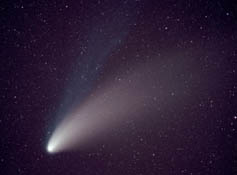
Ben
Harder describes various theories that are currently doing the rounds in
scientific circles. Up until recently the leading theory was the
notion that the oceans were deposited by comets impacting the newly formed
Earth (the ‘late-veneer’ hypothesis) (2). This bombardment occurred
over a billion years (and might also explain how life appeared on Earth
so early in its geo-history). But according to Ben Harder’s article,
recent data from comets has overturned this possibility. The problem
is that the isotopic ratios of terrestrial water and cometary ice are quite
different.
The comets analysed thus far contain relatively
large quantities of deuterium, yet this isotopic form of water is rare
on Earth. If this composition of known comet ice is representative
of solar system comets in general, then very little of the Earth’s water
can be attributed to cometary impact following the Earth’s formation. Taking
this into account, it appears that only half of the Earth’s oceans could
have been deposited by impacting comets. As Ben Harder puts it:
“Assuming that the compositions of Halley,
Hyakutake, and Hale-Bopp are representative of all comets, explaining how
a hail of the objects could produce oceans with an earthly deuterium-to-hydrogen
ratio is like trying to make a low-fat dessert from heavy cream.”
Puzzled scientists have tried to patch
the flagging ‘late-veneer’ theory up, topping up the comet contribution
with that of water-rich asteroids, but that doesn’t explain other problems
to do with the Earth’s chemical composition. The Earth is rich in
many other volatiles, and these elements (mostly noble gases) are not noted
on meteorites. Topping up comet water deposition with that of water-rich
asteroids would not explain the relative abundance of these other volatile
chemicals. For example, recent studies by scientists at the University
of Arizona regarding the relative isotopic ratios of osmium in carbonaceous
chondrites sink the late-veneer theory still further; the upper limit for
deposition of volatiles from space after the Earth’s formation is a meagre
15% (3).
These new findings are causing planetary
scientists a big headache. The natural implication is that the Earth
formed with its volatiles in place right from the start. Yet current
models of the primordial solar system rule this out. Various new
ideas are being floated, in varying degrees of complexity, to explain this
contradiction. Perhaps the primordial inner solar system was a cooler
place than originally thought? Perhaps the Earth was formed from
a multiplicity of planetary ‘embryos’, some of which originated nearer
Jupiter than the Earth, thus allowing a build up of indigenous volatiles?
Perhaps the rocks that formed the early Earth trapped massive quantities
of water within them, preventing the volatiles from being routinely expunged
from the inner accretion disc?
As those cheeky comic chappies from the spoof
Japanese show ‘Banzai!’ would say: “Place your bets now!”
“Betting Ends!”
The solution is staring all of these planetary
scientists in the face. It is so obvious that its absence within Ben Harder’s
otherwise excellent article speaks volumes in itself. The Earth has
a rich mixture of volatiles, including water, because our planet originally
formed much further away from the Sun.
But how much further? Clues can be
gleaned from the ‘embryo’ theory of the Frenchman Allessandro Morbidello
(4). He proposes that the Earth formed from the coalescence of Moon-sized
embryos derived from various chaotic orbits in the primordial solar system.
The ‘volatile carriers’ would have formed at about 4 Astronomical Units;
four times further away from the Sun than the Earth, but still within the
orbit of giant Jupiter. He notes, however, that the water-bearing
carrier from 4 AU would have been geo-chemically unique in the solar system.
Rather like the Earth itself, then?
The data about water isotope composition
in the inner solar system strongly suggests that the Earth formed about
4 astronomical units away from the Sun. This, of course, does not ‘fit’
the standard model for the evolution of the solar system. Yet the
evidence points in this direction, so scientists should be reviewing the
standard model.
If the Earth was once four times further
away from the Sun than it is now, then we must explain how it managed to
find itself in its current close proximity to the Sun. Somehow, it
was shunted into the inner solar system from an orbit originally much closer
to that of Jupiter.

A
model for this action already exists in the form of Zecharia Sitchin’s
‘12th Planet’ hypothesis (5). Upon translating and interpreting ancient
Sumerian cuneiform texts, this scholar proposed that the earliest Mesopotamian
myths were describing the solar system to a high degree of accuracy, but
with a few additional features. Interpreting the myths in an
astronomical context suggested to Sitchin that an undiscovered planet exists
among the comets, one that was not an original member of the solar system,
but an interloper wandering in inter-stellar space that blundered into
the planetary zone.
There it encountered a watery world at
about 4 Astronomical Units, and a great ‘celestial battle’ took place between
these planetary ‘gods’. The result was the shunting of this Water
World, ‘Tiamat’, into the inner solar system, where it became the Earth.
The intruder, ‘Nibiru’, spun off into an eccentric orbit beyond the known
planets, where it remains to be re-discovered to this day.
This is controversial material, of course.
Not the kind of speculative reasoning that readily appeals to the rational
mindset of our academic brethren. But the Water Conundrum we have
just considered is remarkably consistent with this hypothesis. Not
wishing to rely too heavily upon that old die-hard ‘Occam’s Razor’, we
seem to have a simple solution to a difficult problem.
The Origin
of Earth
However, the isotopic evidence about the
cometary ice would also call one of Sitchin’s own claims into question.
He proposes that debris from the impact of the primordial Earth and Nibiru,
and/or one or two of its moons, was scattered into the solar system forming
the asteroid belt, and the comets. Perhaps the formation of the asteroids
may have occurred in this way, but not the comet. The ‘late-veneer’
theory itself is in trouble because the Earth’s oceans could not have been
wholly derived from comets. So conversely the solar system’s comets
could not have been formed from the oceans of the primordial Earth.
If they had then the comet ice isotope ratio would be consistent with that
of Earth.
Current theories of the formation of the
Moon are centred upon a massive collision between the early Earth and a
Mars-sized body, scattering debris into orbit around the Earth, which eventually
coalesced to form Luna (6). The lack of a significant iron core within
the Moon suggests that this impact took place after the Earth’s own iron
core had already gravitated to the centre of our planet (7). It’s
conceivable that the remainder of the early Earth’s scattered debris formed
the asteroid belt, given Sitchin’s proposal, and this possibility is readily
testable by further scientific study of the composition of asteroids within
the belt between Mars and Jupiter. This might have occurred when
the Moon formed, or as a result of later impacts upon the recovering Earth.
If correct, then the primordial Earth must
have been a very significant planet indeed, such that major impacts upon
it created both the asteroid belt and the Moon (but clearly not the comets).
Such a massive terrestrial planet could have readily held onto a vast amount
of volatiles at the original distance of 4 astronomical units. It
also would not be so incongruous that the larger primordial Earth would
have hosted such a massive satellite as our Moon, a point noted by Sitchin
when describing the relationship between the Sumerian Tiamat and ‘Kingu’.
If the Moon came into being following a
collision between the early Earth and a Mars-sized body, then how would
that tally with the ‘celestial battle’ described in the Babylonian ‘Enuma Elish’? The picture is complicated by the scientific discovery of
the ‘late, great bombardment’ upon the Earth/Moon system 3.9 billion years
ago (8). Was this the Celestial Battle described by the ancient Mesopotamians?
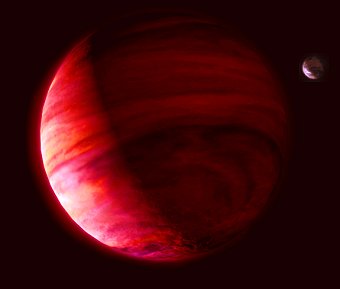
Perhaps the very early Earth (Tiamat) was
cracked originally open by a Mars-sized body, forming the Moon (Kingu).
Tiamat remained a giant watery world with a new, substantial Moon. And
so they might have remained had the solar system not been disturbed by
an interloper.
Nibiru, a wandering giant planet or small brown dwarf
(9,10), entered the planetary zone, bringing with it a ready made contingent
of comets and moons. This latter action may have been the ‘late,
great bombardment’ that occurred 3.9 billion years ago, when thousands
of killer impactors bombarded our planet.
Nibiru’s immense gravity, momentum and
non-orbiting vector perturbed Tiamat and caused it to fall towards the
Sun, attaining an irregular new orbit. Over billions of years, the
resultant Earth was shepherded by the Sun and Jupiter into a more stable
orbit, becoming the rather odd world we now live on, with its over-sized
Moon and excessive water content. Nibiru itself became captured by
the Sun, but remains loosely bound and possibly erratic still, a condition
that prevents the known planets from harmonising their resonances.
Earth’s Special
Character
One final point to note. If the Earth
should not be nearly as wet as it is, being so close to the Sun, then it
is perfectly possible that the Earth is actually a rather special place.
Without the action of a passing intruder planet of vast proportions (and
I consider Nibiru to be no less than a sub-brown dwarf), the Earth would
be a much colder place than it is now. More like ‘Snowball Earth’.
Life relies upon liquid water…would the current bio-diversity on this planet
have arisen if Earth was still at 4 AU? One suspects not.
If a newly forming planet is close to a
star, like Earth is to the Sun, and thus warmed by it sufficiently to maintain
liquid water later in its history, then these exact same conditions should
preclude the inclusion of water on that world in the first place.
The presence of abundant liquid water on the cooled planet becomes a paradox,
because heat and water do not appear to mix when terrestrial planets form.
So this paradoxical situation we currently find on Earth is solved either
by considering the possibility that the Earth has moved significantly closer
to the Sun since its formation, or by rethinking how planets form.

Whatever
caused our world to have so much water so close to the Sun, it may be unusual,
possibly even unique. The Earth’s abundance of liquid water may be very
rare if the action of an intruder planet is required to explain its shunting
into a closer inner orbit. (Saying that, some of the extra-solar
planets found so far have odd orbits; particularly gas giants that whizz
around the parent stars at very close proximity (11). Why was the
constituent gas not blown away by the star before the planet formed?
Does this imply that planetary orbits can change radically, possibly as
a result of outside interference? More planets, please, Dr Marcy!)
Life around
Cool Stars
A final thought. We always assume
that our average boring old Sun is the blue-print for other star systems
that might harbour the conditions for life. Perhaps this assumption
is correct, and the search for Extra-Terrestrial Intelligence should remain
targeted at similar stars to our own Sun. But if Earth’s acquisition
of abundant water is truly an anomaly given the local heat generated by
our Sun upon its formation, then perhaps we should be looking for life
on star systems whose primordial fires aren’t so hot. After all,
the spectrum of stellar characteristics does not begin with our own Sun.
Red, or dare I say, even brown dwarfs would
have formed without the same water-purging enthusiasm as our own yellow
star. I wonder if that means that we should direct our attention
to the less bright members of the celestial family; even those who remain
hidden entirely. These relatively cool stars might have allowed watery
worlds to form more readily around them, and bombard them with less harmful
radiation to boot. SETI may have been searching in the wrong place all
this time.
Water
Worlds
The concept of 'migration' of
planets has becoming increasingly acceptable of late. It was not so long
ago that Tom van Flandern heavily criticised Zecharia Sitchin's '12th Planet
Theory' on the basis that Earth could not have migrated into the inner solar
system from the asteroid belt. Van Flandern argued that Earth's orbit
should still be highly elliptical if that was the case, and the orbit should
still cross through the asteroid belt. These arguments were sufficient to
swing Alan Alford away from the idea of the existence of a substantial Planet X
body (12).
But science has moved on in recent years, and is generally more open to new
possibilities about Planet X (13). This is partly because of discoveries
about our own outer solar system, but also because of the data that has
accumulated about extra-solar planets. Many of these 'exoplanets' have
anomalous orbits. Some of them are orbiting their stars at very small
distances, and are known as 'Hot Jupiters'. These bizarre giant planets
are too close to their stars to have formed where they currently lie (according
to existing theoretical models of planet formation, anyway), so the concept of
'migration' is increasingly mooted to help planetary scientists sleep at night.
If such a model can be widely applied elsewhere, then surely it could have
happened in our solar system too? Possibly even to the Earth?

The science writer Andrew Pike recently described a possible new class of
planets that sound remarkably similar to Tiamat, as described by Sitchin. This
class of planets, called the 'Water Worlds', are still theoretical, but this
looks like a very exciting development for those interested in Tiamat's
transformation into the Earth:
“Alain
Leger of the Institut d’Astrophysique Spatiale, France, has suggested a new
class of exoplanet called a ‘Water
World’. Such worlds would be completely covered in water with no land masses.
They would have twice the diameter and around six times the mass of earth with
orbital distances from their host star about the same as the Earth (1 AU). They
would have a metallic (probably iron) core about 4000 km radius, surrounded by a
rocky mantle 3500kn thick, and be overlaid by a layer of ice 5000km thick
covered by the liquid ocean 100km deep.
“Finally, the
planet would have a gas atmosphere to retain its liquid surface preventing
evaporation into space. Water Worlds would start life in a similar way to
Uranus and Neptune in our solar system. However, in these exosystems they might
then migrate to the warmer inner regions heating up as they go.
“Such
migration is likely to be commonplace in exoplanetary systems. It explains a lot
of features observed there, in particular how the Hot Jupiters formed. These Water
Worlds are still in the realms of speculation but there are a lot of reasons to
believe they might exist and their detection might be closer than we think.
Should one of these Water Worlds pass in front of a Sun-like star it would cause
a dimming in the star’s light of one in a thousand parts which is well within
the scope of planned detection projects like the Eddington and Kepler missions
[designed to widen the search for extra-solar planets].”
(14)
There is so much that we
don't understand about the formation of planetary systems. This can be
only one of a myriad of possibilities, but its early introduction to scientific
speculation would indicate its potential. If such Water Worlds are found
to exist then they would provide a huge lift for Sitchin's theories. Because one
of them may have formed between Mars and Jupiter and, through interaction with
Nibiru, migrated into towards the Sun 3.9 billion years ago, thereby losing
substantial quantities of that water into the solar system. The result, as
they say, is history. Earth's History!
Photosynthesis
Over the years I have described how an
ecosystem might have arisen on a moon orbiting a small brown dwarf, whose light
emission is minimal. It can be easily argued that the conditions on that
moon would be warm enough for liquid water, but some have offered a
counter-argument that there still would be insufficient light for photosynthesis
to take place in the outer solar system. Such light as there is would have
to come from Nibiru, an old and small sub-brown dwarf: a class of failed stars
about which we have little knowledge. Astronomers argue about whether such
bodies can even emit light, but there does seem to be a good possibility that
they do, through chemical reactions in the substantial outer layers of
atmosphere. This would result in 'flaring' of light rather than constant
brightness.
This is rather like arguing for light-emitting
fish in the Deep Sea oceans. Before their discovery no one would have expected
'Angler Fish' at the bottom of our oceans. Is Nibiru the planetary
equivalent of a neon red Angler Fish? Is its moon system lit by this
little oasis of red light in the deep abyss of the outer solar system? I
suggest that it is.
So would this be sufficient for photosynthesis
to take place out there? We can look to events on our own planet to answer
that question, particularly under the Antarctic ice. The scientist Chris
McKay has studied eco-systems that depend upon the dimmest of light emerging
through the ice to trigger photosynthesis:
"Only about 2 percent
of the Sun's light gets through the ice and reaches the cyanobacteria, but
that's plenty bright enough to support photosynthesis. To McKay, in fact,
the ability of some photosynthetic organisms to survive in dim light
carries an important lesson for exobiology "There are plants that
photosynthesize at light levels equivalent to living at a hundred astronomical
units" he says...[which] would extend more than twice as far as the Sun's most
distant planet, Pluto. Therefore, McKay believes, there is no reason to
think that any of our Sun's planets, or similarly placed bodies around Sun-like
stars, are too dimly lit to support photosynthetic life."
(15)
When you add in the warming and local lighting
effect of the dark star Nibiru, then conditions on its moons would be more
favourable still for the emergence of complex ecosystems in the outer solar
system. Game on.
Equatorial Sea on Mars; Confirmed!
Regular
readers of this website will have heard quite a lot about Dr John Murray down
the years; he's an Earth Scientist at the Open University based in Milton Keynes
in England. One of his interests is astronomy, and he was of course one of
the professors who put forward the idea of a brown dwarf in a great circular
orbit around the Sun back in 1999. He's been hard at work again, this time
due to his involvement in ESA's Mars Express mission. His geological
knowledge has been put to the test with these images of ice floes on an
equatorial region on Mars (16,17).
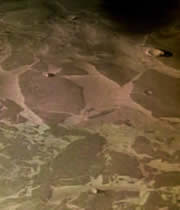
A press release by University College London (UCL) confirmed
the finding after a recent presentation to ESA scientists at a conference in the
Netherlands. The imaging camera on Mars Express seems to have caught a sea
frozen just 5 million years ago, then covered in volcanic dust, preventing the
sublimation of the ice by Mars' frigid and thin atmosphere. The BBC carried the
news this morning, highlighting the additional finding of methane gas over the
same general area. The combination of a deep body of water and methane gas
is strongly suggestive of life existing presently under the Martian surface.
The sea itself is about the size of the North Sea off the
east coast of the United Kingdom, and has an average depth of about 150 feet.
It is located in the area of Mars known as Elysium, 5 degrees north of the
equator.
The press release says that
when water levels sank on Mars, pack ice seems to have
grounded on islands, and thick ice formed in craters. The flat surface of the
planet in the area studied ``suggests that most of the ice is still there.'' Ice
on the surface of Mars isn't stable because of the planet's low atmospheric
pressure. While frozen water would normally sublime -- or change straight from a
solid state into vapour -- on the planet's surface, the frozen sea is protected
from this process by a covering of dust and ash, the university added (17)
This seems to be very good evidence for the existence of life
on Mars. Surprisingly, this information is not making headline news like
the discovery of the controversial meteorite ALH1004 did. Perhaps ESA have
a little less clout with the media than NASA? Even so, this is a real coup
for the European Space Agency who recently were in jubilant mood after the
incredible success of the Huygens probe's descent onto Titan.
Because the sea is relatively young in geological terms, Dr
Murray suggests that the finding implies the presence of other pockets of liquid
water on Mars throughout Martian history.
"I was expecting
glaciologists to be sceptical of our interpretation," he said "But
when I showed the pictures to an expert on sea ice, he was utterly convinced."
(16)
The confirmation of the presence of liquid water on Mars is
exactly what we've all been waiting for. It should accelerate the search
for life on the red planet and further out into the Solar System.
Has Deep Impact' proven Sitchin's
Theory?
On
4th July 2005 NASA celebrated American Independence Day in style. It had
sent a space-probe called Deep Impact towards a run-of-the-mill short period
comet called Tempel 1. As the probe approached, it dropped a smaller
probe, about the size of a washing machine, into the path of the approaching
comet. The impact not only created a great fireworks display for the
watching telescopes, but it also promised to give astronomers a rare glimpse of
the interior of a comet.
Over a month later, we are still awaiting the results of the
spectrographs taken by various research groups connected with the project.
It turns out that we have some more months to wait yet. One wonders why.
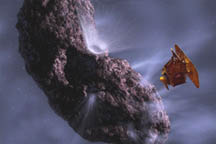
Recently, the author and journalist Linda Moulton Howe
published an interview with Dr Carey Michael Lisse, Prof. of Physics at the
University of Maryland, a member of the Deep Impact Science Team (18). He
was about to attend the 9th International Asteroids, Comets and Meteors
Conference in Brazil, and shared some of the material he was about to present
there. He explained that the scientific work was still on-going, dependent as it
was upon calibration of spectrographic data. But preliminary results were
both exciting, and also rather puzzling.
It turns out that Comet Tempel 1, which is composed mostly of
water ice, contains every rock-forming element found on Earth. It also
contains carbonates, indicating rock similar to limestone. This is very
odd, because limestone requires a liquid water environment to form, as well as
other ingredients like silicates.
How did a comet meandering slowly through the frigid outer
solar system end up with limestone in its rocky composition? It doesn't
seem possible, based upon our current knowledge of the formation of Solar System
objects.
There's another problem emerging from the Deep Impact data.
Comet Tempel 1 doesn't seem to have iron amongst its elemental constituents.
This is also very odd, because iron is a common element in the Solar System.
Now, it may turn out that these preliminary findings aren't complete, and that
other data has yet to come out to explain these oddities. But if there's
some truth to this information then there should be some good news for Mr
Zecharia Sitchin here. Why? Because it may be possible that this
humble comet is about to prove his "12th Planet Theory".
If limestone can't form in a standard comet environment, then
the implication is that the semi-rocky interior of Tempel 1 first formed in a
planetary embryo, if not part of a full-scale major planet. This comet
would seem to have once been part of something much bigger than itself.
Keen-eyed readers will recall a moment ago that Professor Lisse said that all of
the elements found in rocks on Earth are present in this comet. Is this a
coincidence? What's going on here?
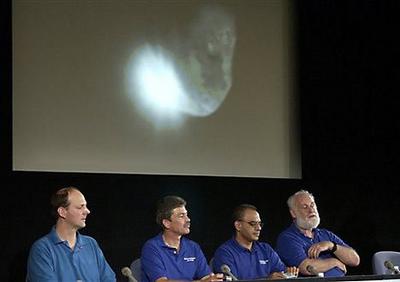
Lee Covino, the New Yorker who has just edited my new book,
is very excited about the Deep Impact data (or lack of it so far). He
thinks that there is something strange about this news blackout, because this
data should have been available almost straight away. Instead, the
scientists are sitting on it, and plan to release it gradually through the
astronomical and astrophysical journals. That seems to run against the
grain of media-friendly science, where NASA catapults every shred of news into
the media as soon as it's available. One would have thought that Deep
Impact was a media-friendly piece of science that would command world attention.
So why the caution being displayed by NASA scientists on this occasion? Is
there something about this data which is making them uncomfortable?
Well, what if Comet Tempel 1 is basically a big chunk of
watery Earth rock? What if the composition of its elements and isotopes
matches that of our own planet? How on Earth could the scientists explain
that one? Comet Tempel 1 is a standard short range comet, implying that
its composition may be shared by other comets. They can't all be icy rocks
originally from Earth, can they?
They could if Sitchin is correct. If Earth's primordial
precursor was a larger, watery version of our world, and was struck by a massive
planetary object, then chunks of that early Earth could have been sent spinning
through the Solar System. Earth itself then migrated inwards, as we have
discussed above. Not only that, but such a theory would explain the lack of iron
on Comet Tempel 1. The iron making up the Earth tends to sink to the core,
meaning that a surface strike would have sent a disproportionate quantity of
iron-poor rocks into space. Hence, the resultant comets would have no
iron. But they would have plenty of water ice, as this comet shows.
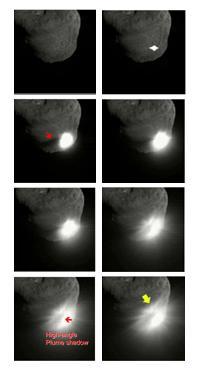
If the isotopic ratio of the water blasted out of Tempel 1 by
Deep Impact is the same as Earth, then Zecharia Sitchin will have good reason to
host his own fireworks party. The data will prove that these comets
resulted from a massive planetary strike on Earth early in the history of the
Solar System.
Some commentators are deeply suspicious of the way the Deep
Impact data is being handled. Richard Hoagland pulls no punches in his
assessment of the situation. He has shown that the claimed difficulties of
obtaining spectra, cited by Dr Lisse, are contradicted by early press releases
by the Deep Impact team (19). These seemed to indicate that everything
went really well just after the impact event, and that great spectra were
dutifully obtained by the scientific teams involved in the project. That's
not what Dr Lisse now says, though. He claims that the mother craft's
instruments were not correctly aligned. It's not yet clear how such
a discrepancy could be accounted for, or how much reliable data will be
forthcoming publicly over the coming months. Richard Hoagland smells a
rat, and I can certainly see the motive behind it if he turns out to be right.
More details have emerged in September about some of the
unusual compounds found within Tempel 1:
"There are also surprise
ingredients, such as clay and chemicals in seashells called carbonates.
These compounds were unexpected because they are thought to require liquid
water to form. "How did clay and carbonates form in frozen comets?"
asked Lisse. "We don't know, but their presence may imply that the
primordial solar system was thoroughly mixed together, allowing material
formed near the Sun where water is liquid, and frozen material from out by
Uranus and Neptune, to be included in the same body."
Also found were chemicals never seen before in comets, such as iron-bearing
compounds and aromatic hydrocarbons, found in barbecue pits and automobile
exhaust on Earth. The silicates spotted by Spitzer are crystallized
grains even smaller than sand, like crushed gems. One of these silicates is
a mineral called olivine, found on the glimmering shores of Hawaii's Green
Sands Beach."
(20)
Either all of the terrestrial bodies in the
solar system have similar chemical constituents and compounds present, or Tempel
1 does indeed sound like a chip of the old block; Earth! Scientists
working on the project wonder whether Tempel 1 is truly representative of
typical solar system comets, however (21). Indeed, they go further,
suggesting that there may be no such thing as a 'typical' comet at all.
Tempel 1, which originate in the Edgeworth-Kuiper Belt, does not share similar
characteristics with other comets which are from the same vicinity.
Perhaps this suggests that the physical environment in the distant
Edgeworth-Kuiper Belt was once more complex than previously thought, which
would be an interesting revelation in itself.
This comet may be provoking more questions
than providing answers.
Water on the Moon - the
implications
NASA's data about Moon rock composition over the last 40
years has been very consistent. The non-polar regions of the Moon are dry,
desiccated, dead. Until yesterday. NASA announced that data from the
Indian Chandrayaan-1 lunar orbitor indicates that
there is a relative abundance of lunar water - even in areas exposed to the
Sun's rays. At 750 parts per million, a ton of lunar rock would yield
about a litre of water (22). Helpful for future missions.
But, how on earth did NASA get this so wrong
for the last 40 years? The Apollo astronauts brought back piles of Moon rocks,
many of which were analysed for water. Traces were found at the time, but
NASA claimed that "most of the boxes containing the lunar samples leaked
which led scientists to assume traces of water found came from Earth air that
had entered the containers". 750ppm is not a trace. And how about the
boxes which did not leak? What of the water composition in them?
Then
there are the NASA probes in the late 1990s,which deliberately set out to
discover water on the Moon. They found frozen water in deep polar craters.
But Clementine, and particularly Prospector, were set up with spectrometers
capable of detecting water across the surface. How did they miss it?
They certainly shouldn't have!
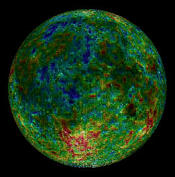
Here's the Mission guidelines for
Prospector's spectrometers:
"Lunar Prospector (LP), which was launched on January
6, 1998, carries an integrated suite of three spectrometers. A Gamma-Ray
Spectrometer (GRS) and a Neutron Spectrometer (NS) are providing global maps of
the major and trace elemental composition of the lunar surface, with special
emphasis on the search for polar water-ice deposits, implied by the H
abundance...Global mapping of elemental abundances by the LP GRS
and NS will impose major new constraints on the bulk composition of the lunar
crust, on compositional variations over the lunar surface, and on the existence
of lunar resources including polar water ice" (23)
The map opposite shows Prospector data from 1998 (24), which has still not
been properly peer-reviewed over ten years on, according to the PDS website (25).
The equatorial map indicates that a fairly detailed, surface wide analysis was
undertaken. So - it begs the question: Why is the Indian data (and
also Deep Impact data, we learn) so radically different? How is it that 40
years of scientific opinion about Moon soil and rock composition has been so
fundamentally overturned? Did God just pee on the Moon? Or is there
something fundamentally wrong with the data that NASA has been making public for
the last 40 years? The BBC news report about the discovery heard that NASA
scientists were 'very sceptical' about the Indian finding at first, simply
because it so comprehensively overturned their previously held beliefs about
water on the Moon (26).
It beggars belief that two American probes sent to comprehensively survey the
Moon just a decade ago could have come up with the wrong data - wrong data that
is consistent with a scientific belief about the composition of Moon rock dating
back to the 1960s. Are we to believe that in the last decade the Indians
have made a quantum leap forward in technology above and beyond NASA and the
U.S. Department of Defense (which controlled Clementine)? I don't think so.
Notwithstanding that puzzling aspect of this story, there are other implications
for the discovery. Water is common throughout the solar system, it
appears. According to theories of planetary formation in the early solar
system, inner worlds tend to have their water veneers driven off by the strong
solar wind of the young vibrant Sun. This is why Mercury and Venus are
dry, and also why the Moon is supposed to be a desiccated shell. Yet, now
it is clear that the Moon is not that dry at all. If the Moon was formed
by an early collision between the early Earth and a Mars-sized planet, as is
currently accepted, then why does the Moon have this water? It should have been
driven off long ago. NASA argues that this water 'comes and goes' with the
long lunar day - and therefore is part of a continuing chemical process
activated by the Sun's rays.
We return to the great water conundrum that features prominently in my book
'The Dark Star' (27).
Isotopic studies of solar system water are essential to understand the point of
origin of any given water bearing object, as the ratio changes with distance
from the Sun, roughly. This is complicated by collisions with comets which bring
water from the outer solar system. The Earth is a puzzle in this regard, and I
have suggested that this puzzle is best solved by the recognition that Earth
began at a more distant orbital point, and then migrated in to its current
position, perhaps due to a collision. That the Moon still holds quantities
of water in its surface soil and rocks strengthens that point. An essential next
step is to establish whether the isotopic ratio for that Moon-water is more like
a planetary object beyond Mars than one at Earth's current location.
The LCROSS Mystery
An essential next
step is to establish whether the isotopic ratio for that Moon-water is more like
a planetary object beyond Mars than one at Earth's current location. The
answer to that question would surely have been solved by the planned impacts of
two parts of the LCROSS spacecraft into the lunar surface. NASA expected a
plume of dust and rock to result from the 5,600 mph collision, but there was no
obvious sign of any plume from either collision (28). However, closer
scientific analysis eventually provided exciting news about ice on the Moon:
NASA confirms a "significant
amount" of frozen water
Ice in large quantities on
the Moon has been confirmed by NASA as a result
of the LCROSS mission:
"A
'significant amount' of frozen water has been
found on the moon, the U.S. space agency NASA
said Friday, boosting hopes of eventually
setting up a permanent lunar base. Preliminary
data from a moon probe "indicates the mission
successfully uncovered water in a permanently
shadowed lunar crater," NASA said. "The
discovery opens a new chapter in our
understanding of the moon," it added in a
statement. The data was found after NASA sent
two spacecraft crashing into the lunar surface
last month in a dramatic experiment to probe for
water. One rocket slammed into the Cabeus
crater, near the moon's southern pole, at around
5,600 miles (9,000 kilometers) per hour. It was
followed four minutes later by a spacecraft
equipped with cameras to record the impact." (29)
Robert Massey of the Royal
Astronomical Society speculated that the 'frozen
water' was brought to the surface of the Moon by
comet impacts. (30) The large debris plume rose
at least one or two kilometres in altitude. It
stayed just below the crater rim, which may have
prevented astronomers from observing it from
Earth. (31) Lee Covino, one of my editors, has a
keen interest in data about water sources in the
solar system. He and I agree that the returning
data from comets and asteroid exploration in
recent years has consistently pointed to
anomalies which can be explained by planetary
migration and catastrophism in the early solar
system, involving a Planet X entity. He
points out that the NASA press release about the
LCROSS findings hint at the prevalence of other
volatile materials in the Cabeus crater.
Here are the excerpts themselves:
-
"In addition, water, and other compounds
represent potential resources that could
sustain future lunar exploration."
-
"The concentration and distribution of water
and other substances requires further
analysis, but it is safe to say Cabeus holds
water."
-
"The LCROSS science team along with
colleagues are poring over the data to
understand the entire impact event, from
flash to crater, with the final goal being
the understanding of the distribution of
materials, and in particular volatiles,
within the soil at the impact site."
-
"Along with the water
in Cabeus, there are hints of other
intriguing substances." (32)
If water was deposited by comets, then there might also be present on the
surface of the Moon organic material from the same source. Given that the
water ice is held within the lunar soil, then it seems reasonable to suppose
that comet-sources organic material and volatiles might also be prevalent within
the lunar soils. Such a discovery would be even more profound than the
confirmation of frozen water. The building blocks of life could be present
within lunar soil, brought to the Moon over billions of years by comets.
All of which begs the question - why was this not realised when
the lunar rocks, returned to Earth by Apollo, were analysed decades ago?
It's perhaps forgivable to mistake water in the lunar soil samples for
contamination. Would missing the presence of organic compounds on the Moon
be an omission too far?
This essay continues here:
The Great
Water Conundrum 2
Written by
Andy
Lloyd,
2 April 2002, 15 Feb 2004, 22 Feb 2005, 16- 23 Aug 2005, 25 Sept
2009, 14 Nov 2009, 10 Jan 2011, 7 and 20 Oct 2011
author of 'The Dark Star'
(2005), 'Ezekiel One'
(2009), 'The Followers of
Horus' (2010) and 'Darker Stars' (2019)
Published by Timeless Voyager Press

 Darker Stars
Darker Stars
References
1) Ben Harder “Water for the
Rock: Did Earth's Oceans come from the Heavens?” Science News, 23 March
2002; 161(12) Thanks to Lee Covino
thefreelibrary.com article
2) Aramand Delsemme “An Argument
for the cometary origin of the biosphere” American Scientist, 89(5):
432-442, Sept-Oct 2001
proquest.com article
3) Michael Drake & Kevin Righter “Determining the
composition of the Earth” Nature, 416: 39-44, 7 March 2002
nature.com
article
4) Alessandro Morbidelli et al.
“Source regions and timescales for the delivery of water to the Earth”,
Meteoritics and Planetary Science, 35(6): 1309-1320, November 2000
onlinelibrary.wiley.com article
5)
Zecharia Sitchin “The
Twelfth Planet” Avon 1976
 The Twelfth Planet
The Twelfth Planet
6) Leonard David "Long-Destroyed
Fifth Planet May Have Caused Lunar Cataclysm, Researchers Say" 18 March 2002
(article on longer available online)
7) Joan d’Arc “Space
Travellers and the Genesis of the Human Form” p29 The Book Tree 2000
 Space Travelers
Space Travelers
8) I. Semeniuk "Neptune Attacks! Early solar
system cataclysmic impact model involving Uranus and Neptune", New
Scientist 7 April 2001, pp26-9
9) Andy Lloyd
“Winged
Disc: The Dark Star Theory” 2001
 The Dark Star
The Dark Star
10) Andy Lloyd “Synopsis
of The Dark Star Theory”, pp50-5, UFO Magazine August 2001
11) G. Marcy & P. Butler
"Hunting Planets Beyond", Astronomy, 28(3): p43-7, March 2000
12} Alan Alford "The Phoenix Solution:
Secrets of a Lost Civilization",
Hodder & Stoughton 1998pp171-4,
 The Phoenix Solution
The Phoenix Solution
13) Andy Lloyd "Planet X: Past and
Present" UFO Magazine, January 2004, pp32-7,
14)
Andrew Pike
“Exoplanets: What’s New?” UFO Magazine, February 2004,
p72-3,
15) David Koerner & Simon LeVay "Here
be Dragons: The Scientific Quest for Extraterrestrial life" p43, Oxford
University Press 2000
 Here Be Dragons
Here Be Dragons
16) Philip Ball "Mars may have a frozen sea" Nature, 22 February 2005
nature.com news
17) University College London
"Frozen sea discovered near Martian equator from 3D images
of Mars Express" 22nd February 2005
UCL Press Release
18)
Linda
Moulton Howe “Deep Impact Spectra: Carbonate, PAHs and Some
Amino Precursors in Comet Tempel I” Interview with Dr. C. Lisse, Professor of
Physics, 12 August 2005 with thanks to Lee Covino
earthfiles.com news
19) Richard Hoagland "Deep
Impact...Deeper Confusion" 20th August 2005
Enterprise Mission article
20) Whitney Clavin "NASA's
Spitzer and Deep Impact Build Recipe for Comet Soup"
7th September 2005, with thanks to Monika Myers
NASA article
21)
World
Science "No “typical” comets, astronomers suggest based on comet-shoot study"
12th September 2005,
(article on longer available online)
22) Claire Bates "'Widespread water' found on the Moon, opening the way for
man to live there full-time" Daily Mail, 24 Sept 2009
Daily mail article
23) Lunar Prospector Data Maps
(no longer available) but see:
A N Binder "Lunar Prospector: overview" Science 4 Sept 1998
281(5382):1475-6.
pubmed.ncbi.nlm.nih.gov/9727967/
24) The Los Alamos Built Spectrometers (no longer available
online)
25) Lunar Prospector Reduced Spectrometer Data
pds-geosciences article
26) BBC Radio 4 News, 10pm 24 Sept 2009
27) Andy Lloyd "The Dark Star - The Planet X Evidence",
Timeless Voyager Press 2005
 The Dark Star
The Dark Star
28) Ian Sample "Moon Crash Landing Fails to Raise Dust"
The
Guardian, 10 October 2009, p5
29) NASA "LCROSS finds water on the Moon" 13 Nov 2009
NASA article
30) 'P.M.', BBC Radio 4, 13 Nov 2009
31) Jonathan Amos "Large Amounts of Water on Moon" BBC News, 13
Nov 2009,
bbc.co.uk article
32) Jonas Dino, "LCROSS Impact Data Indicates Water on
Moon" 13 Nov 2009 with
thanks to Lee
NASA article
 El Gran Misterio Del Agua
El Gran Misterio Del Agua
Scientific Index
















